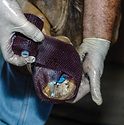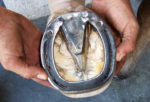Advertise Follow Us
Lamenesses
Educating Clients on the Arthritic Horse
New owners may not be aware of what can be done for a stiff and sore animal
Read More
Flip-Flops Gaining Foothold In Show World
New York farrier shares some advantages and disadvantages of the pad
Read More
Casting As An Option In The Farrier’s Toolbox
Practitioners believe that poor practices can lead to some farriers’ misunderstandings and misgivings about the modality
Read More









